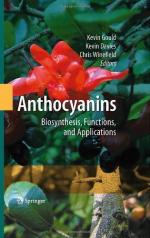|
This section contains 180 words (approx. 1 page at 300 words per page) |
Anthocyanins are a class of molecules pervasive in plants that are responsible for the showy bright purple, red, and blue colors of flowers and variegated leaves. Anthocyanins are located in the vacuoles of cells, and different genes control the particular shades of colors. Aside from their coloration, anthocyanin molecules are also active in plant defense mechanisms against insect and fungal attacks and in the recognition of nitrogen-fixing bacteria by leguminous plants (providing a molecule that attracts the bacteria). Approximately twenty genes are involved in the formation of the anthocyanin molecule with various amendments, such as hydroxyl groups or glucose alterations, to vary the coloration and cause the molecule to function in a particular way. In maize, there are two major types of genes, regulatory and structural, that control the formation of the anthocyanin molecule used to give the corn kernel its color. The variegated Indian corn is caused by an interruption of the color formation by an insert in one of these genes, thus releasing the gene to form color.
 Structure of anthocyanin.
Structure of anthocyanin.
See Also
|
This section contains 180 words (approx. 1 page at 300 words per page) |


